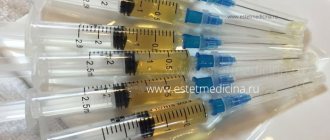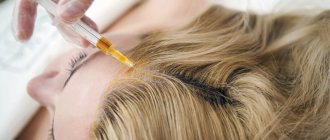Plasmolifting: preparation for the procedure
The course of treatment with plasma lifting is prescribed individually based on indications by an experienced doctor. Preparation before plasma lifting necessarily includes a set of standard blood tests, namely:
- clinical and biochemical;
- tests for markers of HIV, hepatitis and other infectious diseases. If necessary, the doctor prescribes a series of examinations to identify possible contraindications. If they are not there, then after examination and consultation with a specialist, you can prepare for the plasma lifting procedure.
Before the plasma lifting procedure, you must undergo a standard set of tests. This includes a clinical blood test, blood tests for markers of various infectious diseases (syphilis, hepatitis, HIV and others), and a biochemical blood test.
How does the procedure work?
The plasma lifting procedure is quite simple. It is carried out on an outpatient basis and lasts about an hour. To eliminate pain, local anesthesia is used. At the first stage, the doctor at our center will draw blood from the patient into a test tube, approximately 9-20 ml. Next, the test tube with the material is processed in a special centrifuge, during which the blood is divided into fractions: red blood cells and plasma with a high platelet content. The latter becomes the active ingredient of the procedure.
IMPORTANT!!! One of the key factors ensuring the effectiveness and safety of the procedure is the use of original tubes.
Test tubes for plasma lifting contain:
- Anticoagulant (sodium heparin), which prevents blood clotting and prevents platelet aggregation (sticking together)
- A separation gel filter that separates platelet suspension from blood components and allows one to obtain autologous plasma with pronounced therapeutic properties. The forming separation layer does not allow the red blood cell mass to mix with the plasma even when the tubes are in a horizontal position.
At the second stage, platelet-rich plasma is injected into the skin of the problem area. Released in the skin, the active components of the plasma begin to work after the first procedure, and a sustainable rejuvenating and healing effect becomes noticeable after the second or third session. In most cases, to eliminate age-related manifestations, 4-5 procedures are sufficient, which are carried out at intervals of 2-3 weeks.
How to prepare for the plasma lifting procedure
Many patients are interested in the question of whether it is possible to eat before plasma lifting and whether it is necessary to follow a strict diet before the procedure. Experts recommend carrying out autoplasma therapy in the first half or 2-3 hours after eating. However, if for some reason the procedure is postponed until the second half of the day, you should not fast; fatty and spicy foods are not recommended.
|
|
Sign up for treatment
The course of plasma lifting treatment does not imply any diet before the procedure (low-calorie, protein-free or other type). The entire diet before plasma lifting consists of eating healthy food rich in vitamins and microelements with a minimum of fat, salt and spices. A few days before the procedure, it is recommended to give up fast food, alcohol and smoking. The amount of water drunk 2-3 days before the start of therapy should be increased to 1.5 - 2 liters. Before plasma lifting, you should not take medications that affect blood clotting, namely:
- pro- and anticoagulants;
- medications that contain aspirin.
Orthopedic doctor Andrey Sergeevich Litvinenko comments:
The procedure for introducing autoplasma lasts no more than 20-30 minutes. After plasma lifting, it is advisable to adhere to a healthy lifestyle and reduce physical activity for a short time.
Plasmolifting in cosmetology
Injection cosmetology is a popular and effective area of aesthetic medicine, which has many fans around the world. But not all patients are in a hurry to resort to “beauty injections” because, in particular, they are wary of cosmetic preparations, despite their safety and the availability of all certificates. For such people, plasma lifting - injections of their own plasma - will be a real salvation in caring for their beauty. We talked with our dermatovenerologist, cosmetologist and trichologist Irina Anatolyevna Orlova and found out why you should pay attention to this procedure.
What is good about plasma lifting?
This injection procedure has enough benefits that have made it popular among patients. Firstly, this is the scope of its application: with the help of plasma lifting you can improve the condition of the skin, cure problematic skin with acne and post-acne scars, rejuvenate it and give it elasticity. Secondly, the use of the skin’s own plasma makes the procedure completely hypoallergenic. And thirdly, it has a wide range of applications and can be performed not only on the face, but also on the scalp. Many doctors recommend starting your acquaintance with injection cosmetology with plasma lifting.
What is facial plasmolifting?
Many Internet users mistakenly compare plasma lifting and mesotherapy, but in essence, mesotherapy is a technique for administering any medications in microdoses.
Once in the skin, the plasma starts the process of cell regeneration, which is evident from the result of the procedure: the face acquires radiance, skin tone increases, and fine wrinkles are smoothed out. Plasmolifting can be performed both in youth and in adulthood, because it will be useful for the skin of the face and head at any age.
When should plasma lifting be done?
How do you know when it’s time for you to undergo facial plasma lifting? It’s very simple, this procedure has its own number of indications:
- Age-related skin changes (chronoaging)
- Deterioration of skin condition after sun exposure (photoaging)
- Acne and post-acne
- Sensitive, “stressed” skin
- Dermatological diseases (atopic dermatitis, psoriasis, eczema)
We've sorted out the face, but what about plasma lifting of the head? Here, too, there are indications for when this procedure will be effective:
- Weak, brittle, split ends hair
- Seborrhea (dandruff)
- Hair loss (alopecia areata/diffuse alopecia/androgenetic alopecia)
- Reduction of hair volume and deterioration in its quality
Plasmolifting for hair
We have already figured out why you need to do plasma lifting for the face, and now let's look at plasma lifting for hair. Due to the fact that plasma microinjections trigger metabolic processes in tissues, this procedure can also be done on the scalp. A plasma lifting course will help your hair acquire healthy shine, strength and “wake up” dormant hair follicles. This means that your hairstyle will gain significant volume due to the fact that new hair will begin to actively grow, which will look well-groomed and attractive. After this, people around you will vying with each other for the phone number of your cosmetologist-trichologist.
Pros and cons of plasma lifting
Any injection procedure has its pros and cons, so we will now look at this in more detail. Analyzing the advantages and disadvantages of plasma lifting, we can definitely conclude that there are more advantages:
- Wide range of applications
- No risk of allergies
- Efficiency
- Safety of the procedure
Among the disadvantages of plasma lifting, the following can be noted:
- Bruising is possible, as after any injection procedure
- A blood draw is required. If you have anemia, low hemoglobin or platelet levels, you will first have to bring these indicators back to normal
Before the procedure, be sure to take a general blood test so that the specialist understands your hemoglobin and platelet levels. If you want to do plasma lifting, check prices and promotions with your cosmetologist.
Plasmolifting and biorevitalization
Cosmetologists recommend that patients not compare these two procedures. During biorevitalization, the active component is preparations based on hyaluronic acid, which deeply moisturize the skin. Plasmolifting also has a moisturizing effect on tissue, but the main effect is in the regeneration of skin cells. If we talk about plasma lifting and biorevitalization of the scalp, then in this regard microinjections of plasma will be more intense in order to activate hair growth. Therefore, when choosing a procedure, consult with a cosmetologist and discuss your goals and wishes. Then he will be able to choose exactly what you need.
Questions and answers from a cosmetologist
How to prepare for plasma lifting?
— Preparation for plasma lifting includes the following steps. The night before the procedure, you should not eat anything fatty, spicy, smoked, or pickled, only a light dinner. A few days before the procedure, you need to drink a little more water. On the day of the procedure, an hour before the session, you should try not to eat anything, but drink enough water. If we are talking about plasma lifting of the head, then be sure to wash your hair the day before the procedure or on the day of the procedure.
How often do plasma lifting procedures need to be done?
-To eliminate imperfections:
For mature and young skin, there are recommendations to do it in a course of 4-6 procedures, once every 1-2 weeks, and then to maintain the effect, you can perform it once a month for a year.
To maintain beauty:
You can perform plasma lifting 1-2 times a year.
Preparation for facial plastic surgery or laser resurfacing:
It is necessary to do 1 procedure a week before the intervention and two weeks after.
What problems can plasma lifting solve?
-Plasmolifting gives the facial skin freshness, glow, good color, deeply moisturizing it and smoothing out fine wrinkles. Plasma injections also add a noticeable lifting effect and correct mild pigmentation and inflammation, such as acne. In trichology, plasmolifting has the effect of activating hair growth, stopping hair loss, and normalizing the condition of the scalp. The procedures can remove itching, burning, seborrhea, and give elasticity to the hair shaft, because they specifically act on its root.
We recommend reading:
- Plasmolifting and orthoplasma
- Treatment of joints with blood plasma
- Autoplasmotherapy of joints
- Plasmolifting for immunity
- Plasmolifting in orthopedics and traumatology
- Plasmolifting in the treatment of the spine
- At what age is plasma lifting performed?
- Plasmolifting of joints
- Plasmolifting of the knee joint
- Plasmolifting: how many procedures are needed
- Why is plasma lifting done?
- Plasmolifting legs
- Recommendations before the plasma lifting procedure
- Plasmolifting for arthrosis
- Plasmolifting for coxarthrosis
- Plasma therapy
- Plasmolifting restrictions
- Plasmolifting for cellulite
- Plasmolifting of the shoulder joint
- Pros and cons of plasma lifting
- Plasmolifting for arthritis
- Treatment of hernia with plasma
- Plasmolifting for injuries and fractures
- Plasmolifting for osteochondrosis
- Plasma therapy and plasmolifting
- Plasmolifting how much does 1 procedure cost?
- Plasmolifting preparation for the procedure
- Plasmolifting of the hip joint
- Plasmolifting with hyaluronic acid
- Plasma therapy for the treatment of joints
- What to combine plasma lifting with?
- Swiss plasma lifting
- Plasmolifting prgf
- Frequently asked questions about plasma lifting
More articles →
The essence of the procedure
The main active ingredient in the plasma lifting procedure is the patient’s own blood, processed by a special method. During this treatment, plasma with an increased concentration of platelets is released. Platelets are known to contain growth factors responsible not only for blood clotting, but also for the regeneration and growth of young tissue. In addition, platelets have the ability to accumulate around problem areas in tissues, thus the action of growth factors becomes targeted. Under the influence of growth factors, new blood vessels grow, as a result of which tissue oxygenation improves, the influx of nutrients increases and, as a result, complexion improves, pigmentation and severity of wrinkles decrease, and the oval of the face tightens
REVIEWS FROM OUR PATIENTS
“ We are sincerely grateful for every review you leave! ”
Add a comment
Alla Vasilievna 12/20/2021 01:18:05
To relieve knee pain, I take Diclofenac (tablets or suppositories). Do I need to refrain from taking this drug before the plasma therapy procedure? If YES, then in how many days? Thank you
Show answer
KHOLIKOV Timur Vyacheslavovich 12/20/2021
Good afternoon For severe pain, it is recommended to take painkillers. During the consultation, we will adjust the treatment and select the best option.
Possibilities of plasma lifting
Plasmolifting is a facial skin rejuvenation technique that is carried out by injecting the patient’s own plasma under the skin. The procedure is aimed at smoothing wrinkles and rejuvenating facial skin. This method was recently developed, but is already enjoying success.
So, plasma lifting means injections of blood that is enriched with platelets. Plasma injected under the skin triggers processes that increase the production of elastin and collagen, hyaluronic acid and stem cells.
All these substances are essential for skin renewal and slow down its aging.
This procedure allows you to:
- Activate the skin's immune system.
- Launch the processes of tissue regeneration and healing.
- Normalize metabolism.
- Stimulate the production of hyaluronic acid, collagen, elastin.
- Replace old cells that have stopped functioning normally with new ones.
The effect that plasma lifting provides at the cellular level allows you to solve many different problems. And this applies not only to cosmetology; plasma lifting also demonstrates its effectiveness in trichology and dentistry.
Plasmolifting in cosmetology can cure external age-related changes, as well as improve skin tone, moisturize it, and correct the shape of the face.
Why do they contact us?
- No queues
No need to wait, we work by appointment
- All in one day
Doctor's appointment, diagnosis and treatment on the day of treatment
- Let's relieve the pain
We relieve pain in just 1-2 visits to us
- We guarantee
Professional approach, affordable prices and quality
- Doctor's appointment 0 RUB!
If the cost of treatment is more than 30,000 rubles
- Three treatment options
We will select several methods and offer optimal treatment
Combination with other procedures
Plasmolifting is a very flexible procedure. The main active ingredient is always a person’s own plasma, but it can also be combined with other drugs and hardware techniques. This allows you to enhance the effect of the procedure, prolong the result and complement it. for example, we add hyaluronic acid, peptides and amino acids to the composition of the drug. In our center we combine plasma lifting with laser procedures. As a result, the procedure gives a lifting effect, moisturizes the skin, treats acne and post-acne, etc.
Who is contraindicated for plasma lifting?
Unfortunately, this effective procedure is not suitable for everyone.
It is recommended to refrain from such treatment if:
- oncological diseases
- acute infections
- mental pathologies
- diabetes mellitus
- HIV
- hepatitis C and B
- pregnancy and breastfeeding
- individual intolerance to heparin
- disruption of blood clotting processes and speed
What procedures can it be combined with?
It often happens that a cosmetologist can prescribe several options for affecting the skin at once. This allows you to achieve maximum results and maintain them for many months.
Plasmolifting goes well with:
- mesotherapy
- biorevitalization
- correction of age-related changes using Botox drugs
- photorejuvenation, etc.
A competent cosmetologist will select a personalized regimen of skin care and care, taking into account the individual characteristics of the patient.
Indications for plasma lifting:
- Decreased elasticity and dry skin
- All types of hair loss (except scarring)
- All forms of acne
- Skin restoration after plastic surgery, chemical peelings
- Skin rehabilitation after active tanning
- Initial stages of skin drooping (ptosis)
- Preventing the formation of stretch marks on the skin
- Aging of hand skin
- Skin hyperpigmentation
- Puffiness and dark circles under the eyes
- Sensitive, tired skin
- Skin photoaging
- Small expression wrinkles
Plasmolifting for hair diseases:
Plasmolifting has taken a strong place in trichology. Currently, this method has become one of the most effective ways to treat hair loss. Hair loss slows down within a few days after the first plasma lifting procedure; stops completely - after the second; The work of the sebaceous glands is normalized, the hair structure is restored. After a course of procedures, active growth of healthy and thick hair begins.
Hair loss is a serious problem that affects appearance, the development of stress and, ultimately, reduces a person’s self-esteem. If you are faced with the problem of hair loss, contact the specialists of the ABIA Clinic for help. We will do everything possible to maintain the health and beauty of your hair.
Plasmolifting of the décolleté area
The neck and décolleté skin also needs protection, care and support, just like the skin of the face. Plasma therapy is an excellent choice for preserving the youth and beauty of this area.
With the help of a plasma lifting course for the décolleté area, it is possible to cope with dryness and thinning of the skin, decreased turgor and elasticity, rings of Venus, wrinkles, age spots and spider veins.
Also, due to its naturalness, plasma therapy can restore the skin after such aggressive procedures as deep chemical peeling or laser resurfacing.











